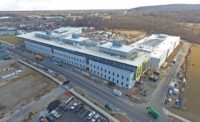Using modules in constructing the PSEG Keys Energy Center has proven to be the right strategy for the $850-million project near Brandywine, Md., cutting time from the schedule and reducing manpower demands. The 755-MW combined-cycle, natural gas-fired power plant faced site issues and labor shortages, but the team’s lean practices helped overcome those challenges.
From the initial planning stage, EPC contractor SNC-Lavalin knew that modules would help reduce potential risks, says Wayne Bullard, senior project director for the firm. “Labor in the area was more scarce than in some other parts of the country, so we made the decision to modularize as much as possible,” he says.
During two years of planning, the team created a design concept that included 20 massive heat-recovery steam generator modules [HRSG], averaging nearly 170 tons each. Large pipe-rack modules were also added to the design, averaging 21.5 tons each.
The use of modules did add significant cost to the project, but Bullard says the technique saves on labor costs and reduces safety risks. “Without modules, we would have at least 25% more work-hours,” he says. “The benefits outweigh the risks.”
Bullard estimates that nearly 2 million work-hours will be logged during the project, with a peak labor force of 850.
Although SNC-Lavalin has an EPC contract, Bullard says that to help fill labor needs the company has had to subcontract nearly 50% of the work instead of using only direct hires.
The project is also bound by local hiring requirements. Keys Energy Center was originally developed by Genesis Energy, a subsidiary of Ares EIF, and purchased by PSEG in 2015. With the purchase, PSEG committed to the neighboring community that at least 20% of workers would meet local business-enterprise requirements and at least 10% would be local minority business enterprises.
After taking over the project, PSEG conducted its own reviews of the SNC-Lavalin design with the help of the owner’s engineer, Concord Engineering. “The pipe-rack modules around the HRSG, in particular, was a great design,” says Ron Rauffer, PSEG project engineering manager. “The modules come in fully fabricated with instrumentation, handrails, grading, insulation, conduits, terminal boxes—just about everything. It’s the way to go.”
Working in 3D CAD, PSEG was able to request needed adjustments to the design. “We focused on operability and maintainability,” says Andy Caplinger, PSEG project director. For example, he says, “There were not many stairways in the original design, mostly ladders for access. We worked with SNC and got several stairways added to the plant.”
In November 2015, when sitework was ready to begin, the team faced its greatest construction challenge. Keys Energy Center is located on a 180-acre parcel that previously was a sand-and-gravel mine. The design called for surcharging the soil rather than using piles. “That’s not the norm for us,” Caplinger says. “We would have gone with piles.”
The team agreed to continue with the original design, but PSEG required an extensive settlement-monitoring program.
During its initial efforts, SNC-Lavalin found that it was unable to sufficiently surcharge much of the surface soil, which was primarily uncontrolled fill.
“It’s mostly sand, but it’s not compactible,” Bullard says. “It’s a spongy material. We tried drying it and re-compacting it, but that wasn’t enough.”
Ultimately, the team removed approximately 300,000 cu yd of material and replaced it with compactible soil.
Although that plan was successful, it set the project back by four months. Construction got under way in March 2016. Now, more than one year later, Bullard says the schedule is back on track to meet the targeted completion date of May 1, 2018. He says the team’s decision to use modules improved its ability to regain schedule, in part because of the reduced labor needs. “We’re working two shifts and currently have 75 on the night shift,” he says. “We’re working some weekends, but no overtime. We’re not having to drive the schedule to that extent.”
While the modules have benefited the project in several ways, they also add some complexity. Transporting pieces that can weigh up to 100 tons to the site requires considerable coordination. The HRSG modules were manufactured in Korea and shipped to Baltimore. From there, they were taken by barge to a port near Morgantown, Md., closer to the site.
Modules were then placed on Goldhofer trailers and transported by road to the Charles County, Md., Fairgrounds, where they were placed on railcars. Less than one mile from the site, modules were offloaded from railcars, put back on Goldhofer trailers and delivered to the site. In several locations, utility lines and traffic lights had to be lifted to accommodate the trailers.
Bridges on two creek crossings, located about one-half mile apart, couldn’t support the combustion turbines’ load, so air bridges were used to bring them across. “We’d cross over, wait until the next night and set it on the next creek,” Caplinger recalls. “There was a lot of coordination, as you can imagine, with state police, local police and utilities.”
Pipe-rack assemblies, which were built in Alabama, also arrive in large pieces, ultimately creating racks that are up to 400 ft long and 75 ft tall. During the life of the project, Bullard estimates 80 truckloads of modules and large assemblies will be transported to the site.
The team aims for just-in-time delivery of modules, Bullard says. Upon arrival, pieces are picked directly from trucks, often using special rigging that comes with the modules. Multiple cranes are required to pick some of the largest pieces. The project has six cranes on site each with a capacity of more than 200 tons; the largest crane has a 1,600-ton capacity.
Once picked from the truck, pieces are set directly on the foundation, rough set and then aligned for final placement. Anchor bolts are preset into the concrete decks, which can be up to 12 ft thick with up to 20,000 cu yd of concrete each.
With pieces in place, crews then make welds that can be up to 3 in. thick on the chromoly pipe pieces. “It takes up to two shifts of four days to get [modules] welded out,” Bullard says. “Then two days to heat-treat them and a half-day to shoot X-rays. If you get one wrong, then you have to do them all over again. We try to find the best welders in the country to make those welds for us.”
At completion, crews will have made 2,406 welds on the project.
Due to the site’s proximity to the military’s Joint Base Andrews, the plant is subject to height restrictions. HRSG height reaches approximately 110 ft. Although the plant’s height is lower than some comparable facilities, Bullard says its vertical demands are still considerable. “Most workers in this area work on light industrial, not heavy industrial,” he says. “So this is more vertical than they are used to. It requires a lot more training.”
Caplinger says the Keys project is the first plant that PSEG has built with such extensive use of modules. The project also marks its first use of full 3D modeling. “The full utilization of that technology was instrumental in our operability, maintainability and constructibility reviews,” he says, noting that PSEG recently awarded SNC-Lavalin a contract to complete engineering on another generating station it is developing in Connecticut.








Post a comment to this article
Report Abusive Comment